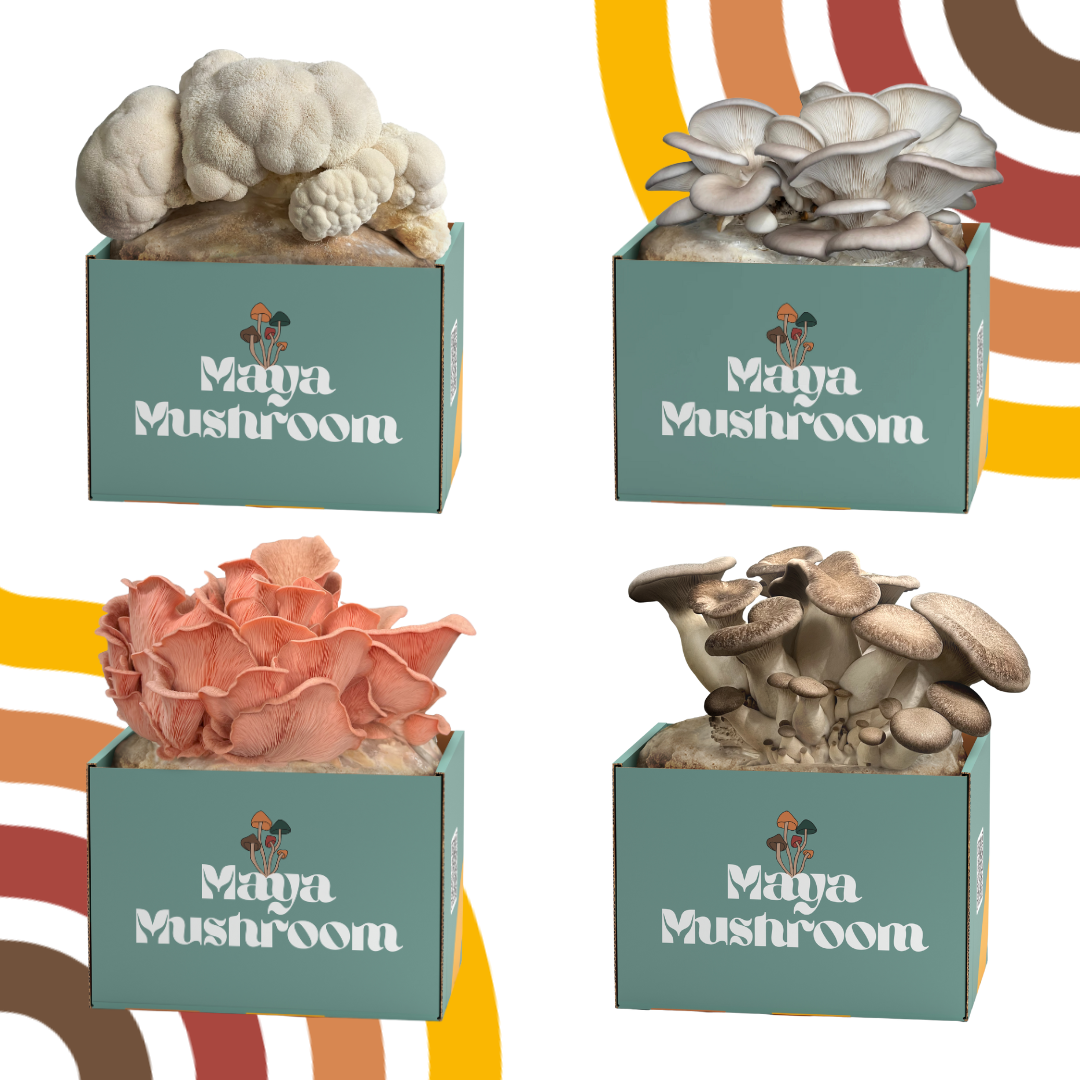The Complete Beginner's Guide to Growing Mushrooms at Home
Lion's Mane and Oyster Mushroom Grow Kits: Everything You Need to Know Before Your First Harvest
There's something magical about growing your own mushrooms. Unlike traditional gardening, you don't need soil, sunlight, or even a green thumb. Just a small corner of your kitchen counter and about a minute a day.
I'll be honest: when I first heard about mushroom grow kits, I was skeptical. How could a block of compressed sawdust produce restaurant-quality mushrooms in my apartment? But after watching my first oyster mushrooms double in size overnight, I became a complete convert.
If you're curious about growing lion's mane or oyster mushrooms at home, this guide covers everything I wish someone had told me before I started.
Key Takeaways
If you only remember three things from this guide, make it these:
- Mushroom growing is easier than keeping most houseplants alive. You need just a spray bottle, indirect light, and one minute a day. No soil, no special equipment, no green thumb required.
- Start with oyster mushrooms for quick wins, then graduate to lion's mane. Oysters grow fast (7–14 days) and forgive beginner mistakes. Lion's mane takes slightly longer but offers that gourmet seafood flavor and brain-boosting benefits.
- Humidity is everything. Most failures happen because the block dries out. Mist 2–3 times daily until you see tiny water droplets on the surface of the "ceiling" (the upper inside of the box), and you're 90% of the way to success.
Why Mushroom Kits Are Perfect for Beginners

Here's what surprised me most: mushrooms are easier to grow than most houseplants. They don't need soil. They thrive in indirect light. And unlike that fiddle leaf fig gathering dust in your corner, mushrooms actually want to grow.
A mushroom grow kit is essentially a fully colonized block of mycelium (the living underground network that produces mushrooms.) Once you open the bag and expose it to fresh air and moisture, the mycelium springs into action, producing those beautiful fruiting bodies you'll harvest and cook.
What to expect from your first grow:
- First harvest: 7–14 days after opening
- Total harvests: Usually 2–3 (called "flushes")
- Daily care: 2–3 mistings with a spray bottle
- Space needed: Just a kitchen counter or shelf
The process is surprisingly forgiving. Mist your ShroomBag a few times daily, keep it in indirect light, and wait. That's really it.
Lion's Mane vs. Oyster Mushrooms: Which Should You Choose?
This is the question everyone asks, and honestly, both are excellent choices for beginners. But they offer completely different experiences.
Oyster mushrooms are the sprinters of the mushroom world. They grow fast, sometimes visibly overnight once they start pinning. They're incredibly forgiving of less-than-perfect conditions, and they have that classic umami-rich, meaty flavor that works in everything from stir-fries to pasta. If you want quick results and a confidence boost, start here.
Lion's mane is more of a patient artist. It takes longer (10-14 days typically), requires slightly more consistent humidity, and grows as a single, stunning white pom-pom rather than clusters. But the reward? A delicate, seafood-like flavor that's genuinely unique, plus the cognitive health benefits that have made it famous in the wellness world.
My recommendation: Start with oyster mushrooms for your first kit. They're faster, more forgiving, and incredibly satisfying. Once you've got a successful harvest under your belt, graduate to lion's mane for the gourmet upgrade.
The Three Things That Actually Matter

After growing dozens of mushroom blocks, I've learned that success comes down to three environmental factors. Get these right, and you're virtually guaranteed a flush.
1. Humidity (The Most Important Factor)
Mushrooms are about 90% water, so they need constant moisture to develop. Your goal is to keep the inside of the ShroomBag humid.
Fold the lid into a triangle roof over your bag. Mist the inside of that ceiling 2-3x a day, not the mushrooms themselves. Mushrooms love humid air, not standing water.
2. Fresh Airflow
Mushrooms breathe oxygen and release CO2, just like us. Stagnant air and high CO2 leads to weird, elongated growth. Lift the lid completely when you mist so fresh oxygen gets in. That's the whole system.
The Mistakes Everyone Makes (and How to Avoid Them)
Giving up too early: The first week often feels like nothing is happening. Then suddenly, tiny pins appear seemingly overnight. Be patient, growth is happening underground before you see it above.
Letting the block dry out: If the surface looks dry and crusty, you've waited too long between mistings. Increase your misting frequency and consider misting the substrate.
Harvesting too late: Pick oyster mushrooms just before the caps start to flatten and curl upward. For lion's mane, harvest when the "teeth" are about an eighth-inch long. Waiting too long results in tough, less flavorful mushrooms and a mess of spores.
Overthinking it: This is the big one. Mushroom growing is remarkably simple, but we tend to complicate it. Follow the instructions that come with your kit, maintain humidity, and trust the process.
What Happens After Your First Harvest?

Here's the beautiful part: after you harvest your first flush, the mycelium rests for about a week, then produces another round of mushrooms.
Just flip the bag 180 degrees and start over. (the flat bottom side of the bag for third flush) Most kits will give you 2–3 harvests before the block is spent.
Between flushes, keep misting to prevent the block from drying out completely, but don't stress about perfect conditions during the rest period.
After your final harvest, the spent block makes excellent compost or mulch for outdoor gardens. Some people even bury spent blocks in their yard and get surprise mushrooms months later. It's worth it to expand spent substrate in hay, straw, or wood chips for more mushrooms at little to no extra cost.
Quick Answers to Common Questions
Q: Do I need special equipment?
A: Just a spray bottle. That's it. One is included with every ShroomBag
Q: What if nothing grows?
A: Give it time. Most kits take 7–10 days before visible pins appear. If it's been 30 days with no luck even if you followed the directions, we'll replace your ShroomBag for free.
Q: Can I grow mushrooms in a small apartment?
A: Absolutely. A single kit takes up less space than a shoebox.
Q: Are homegrown mushrooms safe to eat?
A: Yes. Grow kits from reputable suppliers contain only edible species. Always cook your mushrooms for the best flavor and nutrition.
Q: How do they taste compared to store-bought?
A: Incomparably better. Fresher, more flavorful, and with a texture that store-bought mushrooms rarely achieve.
Why This Matters More Than You Think
Growing your own mushrooms is more than just a kitchen project. It's a small act of food independence. It's watching biology happen in real-time on your counter. It's serving something at dinner that you grew yourself and watching people's faces light up.
After your first successful harvest, when you're sautéing mushrooms you grew yourself in butter and garlic, something shifts. You start looking at those grocery store packages differently. You start wondering what else you could grow.
That's the real gift of mushroom cultivation. Not just the food, but the curiosity and connection it sparks.
So grab a ShroomBag, find a spot on your counter, and prepare to be amazed at what a little block of mycelium can do. Your first harvest is only a few weeks away.



